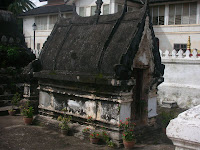
"Luang Prabang -- does it still exist, or was it just a hazy dream I conjured in my imagination? Luang Prabang, the royal capital of the fairy-tale kingdom of Laos, is a beautifully quiet town, dozing in ancient splendor beside the majestic Mekong. A little city of 25,000, it neither teems with excitement nor seethes with intrigue. Life flows slowly here, like the muddy Mekong. The people are gentle and unassuming, accepting the incongruities of life without needing to understand them.
Two lazy rivers happen upon each other in their wanderings through Luang Prabang -- the Nam Khan and the swirling brown Mekong. Traditional Lao houses, high on teak pilings, creep down to the river's edge, engulfed in tall swaying palms and jungle shrubs. Naked children laugh and play here, jumping from high trees into the rich brown river -- bathtub of millions. A few small pirogues drift downstream, carrying fruits or hauling nets. A person could stay here forever and not even realize it.
I entertained just such feelings one misty afternoon, as Jean and I sat resting on a covered terrace overlooking the Nam Khan river. We were perched on the back side of the verdant Phousi, the sacred rock hill that rises up abruptly in the middle of town. On the front side, a grand stairway winds all the way to the top of the Phousi, and a splendid view rewards the arduous climb, especially in the calm of the early morning or at dusk. At the summit sits Wat Chomis, a small temple looking directly down upon the elegant Royal Palace and out over the mountains in all directions.
The temple architecture in Luang Prabang contrasts to the southern Lao and Thai styles. The sweeping tiers of the multiple overlapping "saddle" roofs spread nearly to the ground. The most impressive example is Wat Xieng Thong, standing on a point at the confluence of the two rivers. Laos still has a titular king, who patronizes Xieng Thong as his local temple. The buildings are lavishly decorated with mosaics of tiny red, green, and blue mirrors on a gilded background.
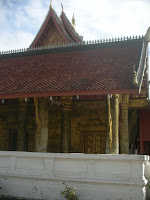
Each temple keeps its own ornately carved wooden longboat (or two) sheltered under a separate canopy on the grounds. Each August a great boat race is held down the Nam Khan river and out into the Mekong. The Royal Boat has never been know to lose, manned as it is by trained royal guards, while the others are paddled by local worshippers.
Coconut palms rise up wherever you gaze in Luang Prabang. Our inn had a large and pleasant courtyard in front, with a kitchen to one side. Here we often ate in the moonlight, filtered through the palms overhead. From the open rafters hung fresh bunches of litchi, bananas, and grass.

Just up the street, a money changer deals in all sorts of foreign currency. The most interesting to me was the Pathet Lao money which, while growing scarce, is still legal tender in northern Laos. The 10 kip note pictures Pathet Lao guerrillas planting bamboo stake 'booby-traps' in the jungle. The 500 kip note is the most extraordinary however; it depicts five women harvesting in the fields, some with babies slung to their sides, and the others with rifles. They are looking up, as in the background anti-aircraft guns bring down an American fighter plane in flames and smoke.
Shopping is still an informal affair in Luang Prabang. As everywhere, the Morning Market is the place to go for food and entertainment. There are hundreds of temporary and semi-permanent shops, stalls, and blankets spread on the ground, where virtually everyone converges to buy and sell most anything. Here the primitive hill tribesman comes face to face with the modern western traveler in a milieu strange to both of them. Yet, life comes easily here and such anomalies are taken, as a matter of course, with a broad smile.
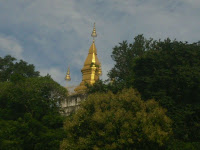
Motorized tri-shaws swarm outside the Morning Market but we preferred to stroll leisurely through the streets of town. Luang Prabang is small enough that you can see much of it in one day if you aren't careful. Several fabulous old French manor houses repose along the shady side streets, reminiscent of colonial days. The antiquated prison, grim and dilapidating, stands on the dusty back side of town, down beyond the old USAID compound.
During the earlier years of fighting in Laos, some of the Meo and Liu tribes people came to live in Luang Prabang itself. But though they live in the town, they have resisted any change in their traditional ways of life. Hidden by stands of banana and palm trees, their villages appear to have been transplanted -- complete with bamboo huts, dirt paths, and water buffalo -- right out of the jungle to the back streets of Luang Prabang.
One morning while strolling by the Nam Khan, we paused outside a little inn where a monkey and a black bear cub were tied to a tree. Inside the inn we caught a glimpse of a little old woman working over a large loom. She chewed her betel as she worked, and flashed a crimson smile when we stepped inside. While we watched, she deftly and patiently plied her shuttle to a magnificent length of heavy cloth, intricately filled with designs of all colors. We admired her work so much that when she later finished it, we took it with us for an embarrassingly low price.
In those brief months of interim peace in 1974, you could also hire a local boatman to ferry you across the Mekong to the deserted caves on the far side. There isn't much there except an abandoned temple overgrown with vines, and a broad green meadow beside the river. But that was reason enough to sit and gaze out across the mighty Mekong at lovely, lazy Luang Prabang, and just let it flow."
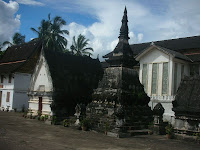
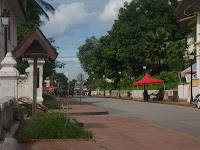
Cheers from Andalusian Province, here in Spain. Nice Blog!
ReplyDelete